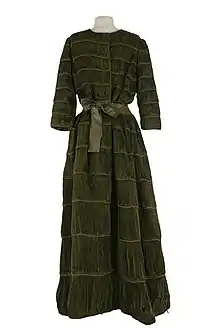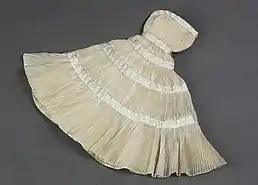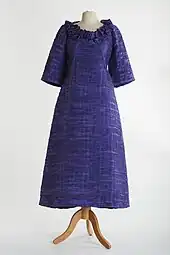Pleated linen
Pleated linen is a form of processing linen which results in a fabric which is heavily pleated and does not crease like normal linen fabric.
History

The earliest form of pleated linen dates from ancient Egypt and can be seen in a garment known as the Tarkhan dress, which is over 5000 years old and is believed to be one of the oldest dresses in existence.[1] Other examples of pleated linen from ancient history include pleated linen from the tomb of queen Neferu.[2] The Museum of Fine Arts, Boston has in its collection[3] four excellently preserved pleated linen dresses, all found in 1902-1903 by George A. Reisner at the cemetery of Naga ed-Deir in Egypt.[4] It is not known exactly how the Egyptians pleated linen, but the material may have been "folded, accordion style, then tied, and wetted."[5]
Modern use

In the 1950s the Irish fashion designer, Sybil Connolly, developed a method of hand-pleating linen with the handkerchief linen manufacturer Spence Bryson.[6] Handkerchief linen is a light form of linen, and this pleating process used 9 yards of the material to create 1 yard of pleated linen.[7] The pleating of the fabric meant that unlike other linen garments, ones made with pleated linen were uncrushable, could be packed without becoming creased and maintained their shape.[8][9] First Lady Jacqueline Kennedy selected a pleated linen creation by Sybil Connolly when she sat for an official Aaron Shikler White House portrait in 1970.[10] Sybil was reportedly very protective of her pleating method, saying it was a secret she would “carry to the grave.”[11]
Gallery
 A moss-green pleated linen evening dress with three-quarter length sleeves and a round high neckline. Designed by Sybil Connolly.
A moss-green pleated linen evening dress with three-quarter length sleeves and a round high neckline. Designed by Sybil Connolly. Grey pleated dress designed by Sybil Connolly.
Grey pleated dress designed by Sybil Connolly. Maquette for a pleated linen cream evening gown named 'First Love' by Sybil Connolly
Maquette for a pleated linen cream evening gown named 'First Love' by Sybil Connolly Pleated linen 'Heiress' dress 1957 by Sybil Connolly
Pleated linen 'Heiress' dress 1957 by Sybil Connolly 'Heiress' dress 1957 by Sybil Connolly - Ruffle detail
'Heiress' dress 1957 by Sybil Connolly - Ruffle detail Lavender evening gown in pleated linen with 3/4 length sleeves and a frilled neckline by Sybil Connolly
Lavender evening gown in pleated linen with 3/4 length sleeves and a frilled neckline by Sybil Connolly
See also
References
- "See the World's Oldest Dress". National Geographic. 18 February 2016. Retrieved 18 January 2022.
- "Pleated linen of queen Neferu ca. 2051–2030 B.C." www.metmuseum.org. Retrieved 18 January 2022.
- "Pleated linen dress". collections.mfa.org. Retrieved 2022-01-26.
- Riefstahl, Elizabeth (1970). "A Note on Ancient Fashions: Four Early Egyptian Dresses in the Museum of Fine Arts, Boston". Boston Museum Bulletin. 68 (354): 244–259. ISSN 0006-7997. JSTOR 4171540.
- "Textiles". Royal Ontario Museum. Retrieved 2022-01-26.
- "Pleats now and then". KDD & Co. 12 June 2012. Retrieved 18 January 2022.
- "Modern Ireland in 100 Artworks: Irish Designer Sybil Connolly". Royal Irish Academy. 1 August 2015. Retrieved 18 January 2022.
- Drohan, Freya. "Sybil Connolly". Women's Museum of Ireland. Retrieved 18 January 2022.
- "Irish Fashion: Textile & Clothing - Second Skin". National Design & Craft Gallery. Retrieved 18 January 2022.
- Tierney, Tom (1985). Great fashion designs of the fifties : paper dolls in full color : 30 haute couture costumes by Dior, Balenciaga and others. New York: Dover Publications. ISBN 0-486-24960-3. OCLC 17308697.
- "Sybil Connolly". FIDM Museum. 2010-06-10. Retrieved 2022-01-26.


.svg.png.webp)